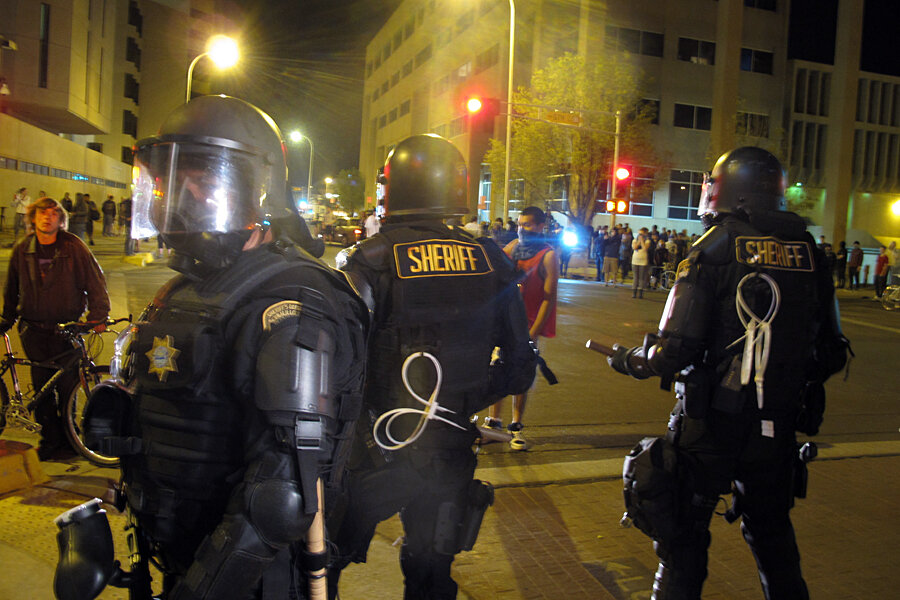Federal report: Albuquerque police have pattern of using 'unreasonable force'
Loading...
Police in Albuquerque, N.M., have a serious pattern of using “unreasonable force” against civilians, especially against those who have mental illnesses, according to a blistering report from the US Justice Department that was released Thursday.
The release of the findings closes a 16-month federal investigation into allegations that officers in the Albuquerque Police Department (APD) are abusing their right to use force, often with fatal results for civilians. Over the past month, outrage over police tactics in the Southwestern city reached its highest-octane levels yet, after police were seen in March fatally shooting James Boyd, a homeless man with schizophrenia, in footage from an officer’s helmet camera.
The Justice Department (DOJ) report concluded that APD officers are overusing both lethal and nonlethal force against people who “pose a minimal threat” to the officers, as well as against people who are clearly mentally ill and unable to properly follow police orders.
“Public trust has been broken in Albuquerque,” said Jocelyn Samuels, acting assistant US attorney general for the Civil Rights Division, at a press conference Thursday to discuss the report.
The DOJ said that the conduct of the APD officers, not the suspects, is often responsible for escalating the situation to violence, and it said that the majority of the 20 fatal police shootings it reviewed between 2010 and 2013 were “unjustified.”
The DOJ also identified “systemic deficiencies” in the APD that have legitimized or condoned excessive use of force, including “poor accountability systems” and “inadequate training.” The APD, it noted, has also failed to create a “culture of community policing” and has a hostile, aggressive relationship with the city it polices.
The DOJ recommended a long list of major reforms for the department, including investigating police shootings as crime scenes and overhauling police training to de-emphasize weapons use.
It did not, however, go so far as to order federal monitoring of the department, as had been expected, but said that federal agents would be meeting with local officials to determine what kind of monitoring would be required to make sure that reforms are carried out. Several cities’ police departments, including those in New Orleans and Los Angeles, have been subjected to federal monitoring.
Last week, in anticipation of the findings, Albuquerque Mayor Richard Berry requested immediate federal oversight of the police department, signaling a willingness to comply with such expected measures.
“Prior to the completion of the DOJ investigation and the publication of findings, I would like to immediately begin to the process of negotiating a cooperative agreement between the DOJ and the City of Albuquerque to implement a DOJ monitoring plan,” the mayor wrote at the time, in a letter addressed to the DOJ.
Mayor Berry, calling Mr. Boyd’s death a “game changer,” had also said that he was setting aside $1 million for compliance with the DOJ’s anticipated recommendations, and he announced support for some 60 departmental reforms, including mandating training for all officers on how to work with mentally ill civilians.
Though a police officer is entitled to use lethal force if the officer believes that his or her life is in serious danger, the number of shootings in Albuquerque – 23 civilians dead since 2010, most of them people with mental illnesses – had put a bright light on what can happen when an officer’s right to fire collides with a mentally ill person’s difficulties in understanding how to follow an officer’s directions.
It had also raised the question of whether APD officers were making all efforts to avoid using force and were abiding by the protocols outlined in their own guidelines for de-escalating and compassionately resolving confrontations with mentally ill suspects.
Last month, a standoff with police in the Sandia Mountains resulted in the shooting of Boyd – even though the situation appeared to have been diffused and Boyd seemed to be cooperating with officers. That month, violent protests over the death tore through Albuquerque’s downtown.
The DOJ investigation, begun in November 2012, did not review the Boyd shooting, but the case is the subject of a federal criminal investigation, DOJ officials say.






